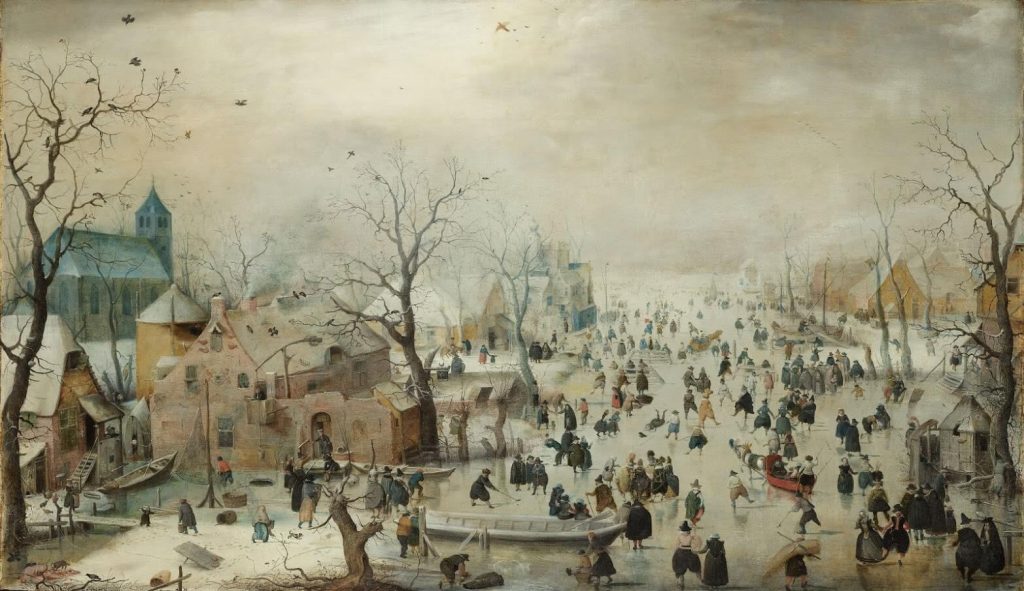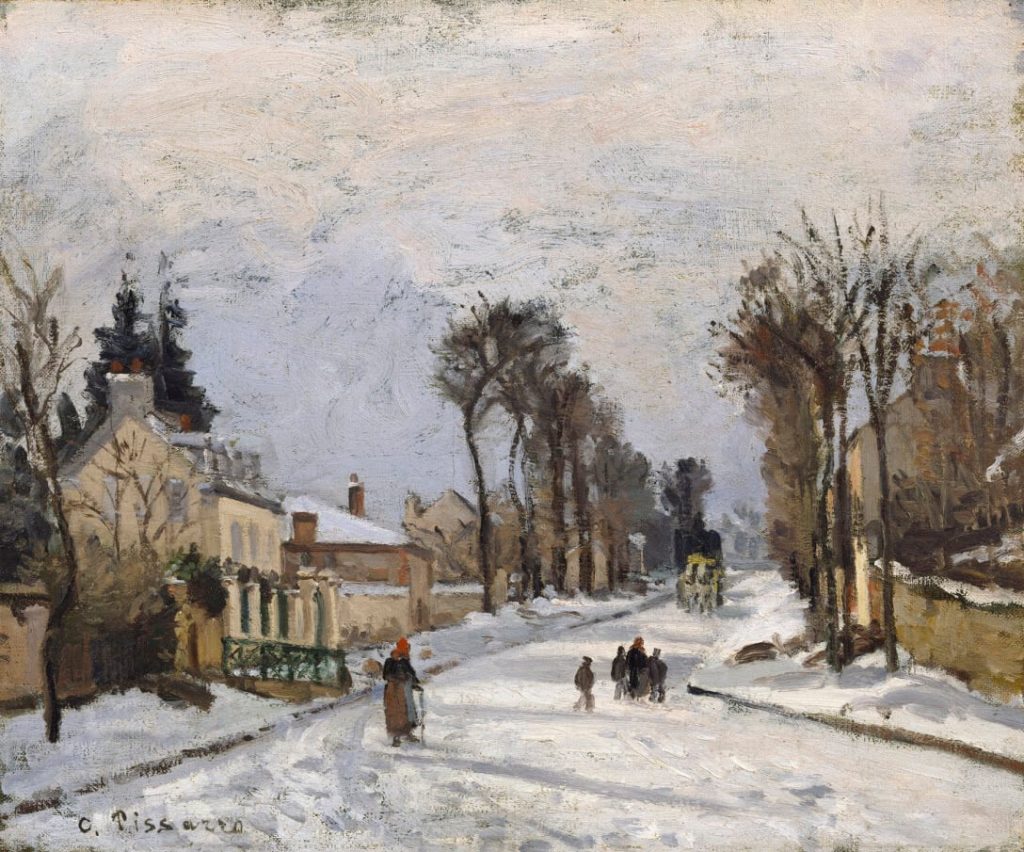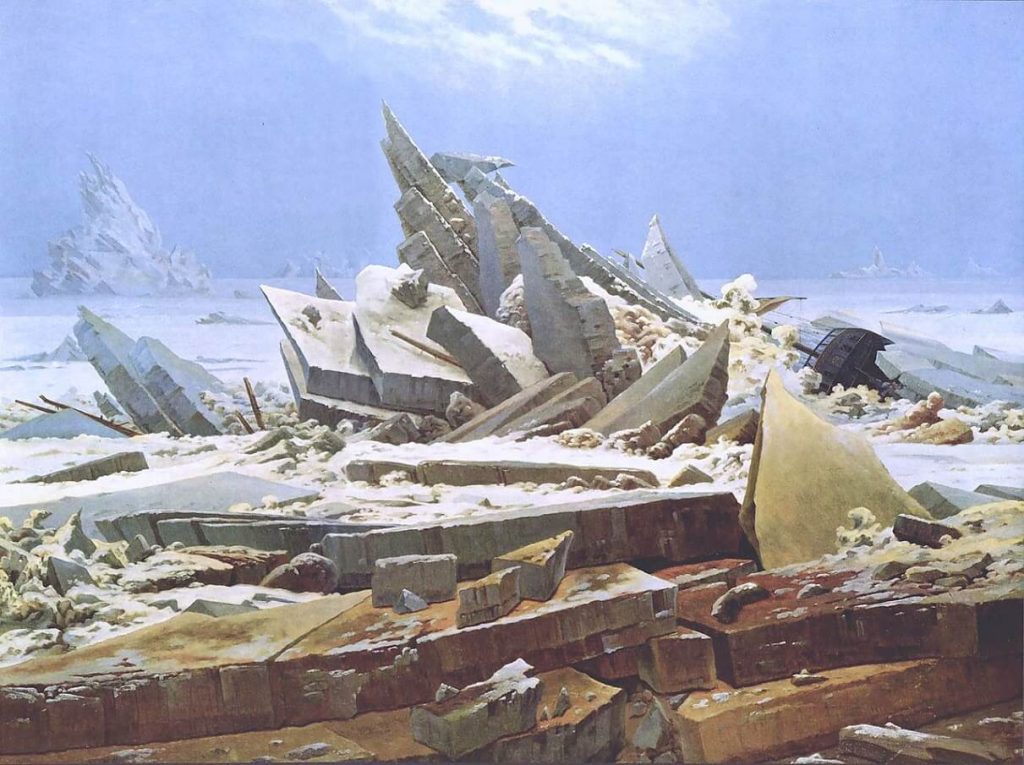Art history is full of beautiful paintings with a winter theme. The whiteness of snow, muted winter light and almost a monochromatic palette fascinated painters since the Middle Ages. A year ago, I curated a winter-themed Art Blogmas. Since it was pretty successful, I’m sharing the 20 most beautiful winter-themed paintings in this article dedicated to winter in art.
Most beautiful winter-themed paintings
Painters were fascinated with different aspects of winter throughout history. During the Middle Ages, artists mainly focused on depicting specific winter works or natural changes. Impressionist painters focused more on reflections of light on snow. There was something specific in winter paintings in any period in history, so here you can find different artworks to show you some of the most beautiful winter-themed paintings.
1/ Gustave Caillebotte: View of Rooftops (Effect of Snow)
We’re starting with the work of the French Impressionist painter Gustave Caillebotte, showing Paris in winter.
Caillebotte wasn’t only a painter, but he was also one of the first artists who started experimenting with photography as an art form. Perhaps this can explain an unusual perspective of this painting.
With numerous shades of grey, he painted the roofs of the Montmartre neighbourhood in Paris. And managed to capture the month of December in the French capital perfectly. You can almost feel the cold through this winter-themed painting, right?
⤷ Read more: Gustave Caillebotte: View of Rooftops (Effect of Snow)
2/ Pieter Bruegel the Elder: The hunters in the snow
In his artwork, Bruegel painted a group of hunters with their dogs returning to the village. The painter included a lot of symbolism in it, too. For example, there are rabbit footprints in the snow in front of the hunters. Showing the animal who escaped them, the painter is almost teasing them for their unsuccessful hunt.
Even more interesting than the main topic of hunters is the landscape – something relatively new in the art of that time. Bruegel here showed the traditional architecture of the Flemish village with a church at its centre.
⤷ Read more: Pieter Bruegel the Elder: The hunters in the snow
3/ Claude Monet: Train in the Snow or The Locomotive
Claude Monet painted this painting in 1875 at the Argenteuil railway station. He painted quite a few scenes with trains, almost as he was fascinated with them.
Observing the texture is something especially interesting when in front of the Impressionist painting. It seems as there is no light on this painting. Monet painted both the snow and the sky with grim shades of grey.
People looking like the black shadows could almost be misplaced for the black tree branches shown at the right-hand side. Although the cold could almost be felt through it, the painting has a certain cosiness.
⤷ Read more: Claude Monet: Train in the Snow or The Locomotive
4/ Vincent van Gogh: Landscape with snow
There aren’t many winter-themed paintings in Van Gogh’s work. So, his Landscape with snow comes a bit as a surprise. However, although he painted a winter landscape here, it’s not as gloomy as some other paintings with winter as their theme.
His sky is blue, and it almost looks as some sunshine will soon appear on it. Shades of green, yellow and brown are depicted on the field. Perhaps, Van Gogh showed the beginning of the spring here?
⤷ Read more: Vincent van Gogh: Landscape with snow
5/ Wouter Johannes van Troostwijk: The Raampoortje in Amsterdam
Although, at first glance, this painting may seem older than it is, it was actually made at the beginning of the 19th century, in 1809. The painter captured winter in Amsterdam perfectly. From the gloomy sky to the frozen canals, all of that is so typical for the Dutch capital.
In a manner of the Dutch Golden Age painters from the 17th century, a painter includes some humour in the painting, as well. A man is urinating just next to the city gates. A lady close to him looks as she’s waiting for him to finish his business. Well, it seems like just the other everyday-life scene from Amsterdam.
⤷ Read more: Wouter Johannes van Troostwijk: The Raampoortje in Amsterdam
6/ Claude Monet: Haystacks (Effect of Snow and Sun)
Claude Monet was utterly impressed by snow. He could play with colours, reflections and textures so well while painting it. Monet is again using so many different colours to show the whiteness of snow. We recognise shades of yellow, ocher, blue, pink, purple etc. His shadows are not grey either. Instead, he uses purple to show the darker areas of the painting.
It’s fascinating how, although his motive is white, and we recognise Monet’s theme and snow immediately, there is no white colour in this painting. Instead, he’s using all those pastel colours to show the winter day and the soft light of the golden hour.
⤷ Read more: Claude Monet: Haystacks (Effect of Snow and Sun)
7/ Paul Limbourg: February
These kinds of calendar images were trendy during the Middle Ages. They often represent labours of the months and peasants busy with the work in the field. Or, aristocrats hunting and enjoying some other leisure activities typical for that time of the year.
It’s the same with our picture, representing the month of February. On the upper part of the image, we can see the calendar and the zodiac signs – showing the Aquarius and Pisces. Below it are the peasants busy with work typical for winter. One of them is cutting down the tree with an axe. We can also see birds in the garden eating seeds.
However, exciting activity is happening inside the house, as well. It seems as people are warming up their arms and legs. However, some of them don’t wear their underpants. Although the nudity may seem unusual for the religious book, surprisingly, it wasn’t that uncommon back in that time.
⤷ Read more: Paul Limbourg: February
8/ Utagawa Kuniyoshi: Nichiren in Snow at Tsukahara
Japanese artist Utagawa Kuniyoshi was a son of the silk-dyer and one of the last 19th-century masters of woodblock printing.
Although the composition may look purely decorative, Utagawa depicts a part of the important historical story in this winter landscape. This print is a part of the series Sketches of the Life of the Great Priest.
Nichiren, a Buddhist priest from the 13th century, is walking through the snow. His surroundings show Sado Island, where he was exiled between 1271 and 1274.
⤷ Read more: Utagawa Kuniyoshi: Nichiren in Snow at Tsukahara
9/ Pierre-Auguste Renoir: Skaters in the Bois de Boulogne
Renoir was one of the most famous French Impressionist painters, well-known for his paintings celebrating sensual women. So, this winter landscape painted in 1868 stands out a bit among his work. Actually, the urban legend says he couldn’t stand winter and cold, and he wasn’t painting outside during the wintertime. Thus making this painting one of his rare landscapes with snow.
The colours on the painting are pretty unusual for him. We’re used to the vibrant pastel colours on his artworks. However, this one almost seems black and white. Unlike how Claude Monet painted snow on his paintings, Renoir primarily uses white and shades of grey. Most of the people in his picture are wearing black clothes, contrasting with the white snow.
⤷ Read more: Pierre-Auguste Renoir: Skaters in the Bois de Boulogne
10/ Claude Monet: Snow at Argenteuil
On his Snow at Argenteuil, Claude Monet uses soft pastel blue and purple shades, making this painting so delicate. With his brushstrokes of blue, purple and peach, he’s creating a texture of soft snow. One can almost hear the squeaky sound of passers-by walking through the deep snow.
But he’s not stopping with the brilliant texture usage there. With the fine lines and the way he’s pulling the brush, we can feel the wind current and the movement of the thin layer of clouds.
⤷ Read more: Claude Monet: Snow at Argenteuil
11/ Lucas van Valckenborch: Winter Landscape with Snow near Antwerp
Lucas van Valckenborch’s painting looks more like an illustration with his pastel and light colours, especially light blue. However, he’s not making it a dreamy fairytale as Claude Monet did on one of the winter landscapes we saw previously.
Quite contrary, he’s including numerous details in his painting. Each group of passers-by are involved in a different story, from the group of people warming their hands next to the fire to the group of boys occupied by a game that looks like an ice hockey.
⤷ Read more: Lucas van Valckenborch: Winter Landscape with Snow near Antwerp
12/ Anton Genberg: Afternoon Mood
In his painting, Anton Genberg used different shades of grey to show the texture of the snow. From the lighter shade of grey, that’s almost white, in the foreground, to the dark grey colour used to show the layer of snow covering the mountains in the background. He showed the texture and sledges marks in the snow with distinctive brush strokes.
He also used texture to paint the clouds. However, in that part of the painting, he applied more of a yellow colour, showing the sunshine behind the clouds.
⤷ Read more: Anton Genberg: Afternoon Mood
13/ Paul Signac: Boulevard de Clichy
Boulevard de Clichy is a famous street in Paris. Today, it’s the most recognised as home to Moulin Rouge. However, during the second half of the 19th century, it was a lively place and often a motif to Impressionist and first modern painters living in Paris. It was also home to Le Tambourin Cafe, where many of those painters met and talked about art. So, it’s no surprise Paul Signac chose it for his lovely winter scene.
He painted it in 1886, and it’s a perfect example of a new style he’s starting to develop – Divisionism.
⤷ Read more: Paul Signac: Boulevard de Clichy
14/ Hendrick Avercamp: Winter Landscape with Ice Skaters
Avercamp used a bit of muted colours to show the depth of space. And soft grey and ocher to paint the light of a winter day. He also depicted the frozen river, something quite typical for the 17th-century winter in the Netherlands.
However, his focus on this winter landscape isn’t nature itself, but rather the people ice skating. He’s showing people from all kinds of backgrounds – from rich to poor. Some of them enjoy ice skating and fun winter activities. On the other hand, the poor are just trying to survive.
⤷ Read more: Hendrick Avercamp: Winter Landscape with Ice Skaters
15/ Paul Gauguin: Winter Landscape
Contrary to his later paintings, on which he used intense colours, often in contrast, this painting seems almost monochromatic. Paul Gauguin uses shades of grey, blue, brown and just a bit of green. With that colour palette, he’s capturing the coldness of a winter day perfectly.
The overall feel we’re getting from this painting is a cold tranquillity. Trees are bare without any foliage on them. And although we could recognise houses, no light or movement is happening around them. Everything stands still in this winter-themed painting.
⤷ Read more: Paul Gauguin: Winter Landscape
16/ Walter Moras: Sledding on a Sunny Day
Although everything is covered with snow, this is not one of those grey sombre winter days. Quite the opposite, there is a lot of blue colour in the snow (instead of grey, as on many paintings we saw before). We can also see the sunshine and feel the brightness of the day.
Moras painted one of those beautiful winter days you just want to spend outside. Children are playing and enjoying winter activities. The detail of two boys sledging brings movement in this rather still winter landscape.
⤷ Read more: Walter Moras: Sledding on a Sunny Day
17/ Jacob van Ruisdael: Winter Landscape
In his Winter Landscape, Ruisdael includes a few motifs typical for the Netherlands – windmills, frozen canal and a woman dressed in traditional Dutch clothes from the 17th century.
During that time, Dutch painters looked for the motif that symbolised the Netherlands in their landscape paintings. They have soon found it in a cloudy sky.
To show it, Ruisdael has a low horizon on his painting, so he can stress that dark cloudy, typical Dutch sky. He’s using muted and darker colours to show the winter mood in the Netherlands.
⤷ Read more: Jacob van Ruisdael: Winter Landscape
18/ Pieter Bruegel the Elder: The Census at Bethlehem
Pieter Bruegel painted The Census at Bethlehem in 1566. It’s quite a particular painting for us because it’s one of the first paintings in art history, with a large portion of it dedicated to the winter landscape.
Bruegel has set up the Biblical scene in a contemporary environment. We can see Mary and Joseph in the middle of the 16th century Flemish village. Although gabled houses and typical Belgian architecture don’t quite belong to it.
⤷ Read more: Pieter Bruegel the Elder: The Census at Bethlehem
19/ Camille Pissarro: Road to Versailles at Louveciennes (The Snow Effect)
Camille Pissarro is a Danish-French painter and one of the founders and most famous Impressionist painters. In 1869 he moved to the suburbs of Paris, to Louveciennes. As many Impressionist painters did, he chose one motif and painted it numerous times, in different seasons and times of the day. His one was the road to Versailles, the one he painted in this winter-themed painting, as well.
Like some other Impressionist winter paintings we already saw, Pissarro depicts the winter with soft brushstrokes and pastel colours. All the houses are painted with a subtle ochre colour. They are making a nice balance with the darker bare trees around them.
⤷ Read more: Camille Pissarro: Road to Versailles at Louveciennes (The Snow Effect)
20/ Caspar David Friedrich: The Sea of Ice
Caspar David Friedrich was a German painter who lived in the 19th century and mostly painted Romantic landscapes. His landscapes are usually mystical and allegorical, showing the fog or the night skies. In style with the time he lived in, Friedrich loved to include Gothic architecture in his landscape paintings.
However, his painting The Sea of Ice is somewhat different. He painted the shipwreck in the Arctic. This painting was so unusual for the 19th century that he didn’t manage to sell it during his life. German newspapers were reporting about a few expeditions to the Arctic at that time, and Friedrich probably got inspired by them.
⤷ Read more: Caspar David Friedrich: The Sea of Ice
With so many beautiful depictions of winter in art, it’s hard to choose only the 20 most beautiful winter-themed paintings. However, here is the selection of some of Culture Tourist’s favourites. Do you have some other winter paintings you’d like to add to this list? Let us know in the comments!
Image sources: Wikipedia





















